Hometown Heroes
Bar U Ranch National Historic Site
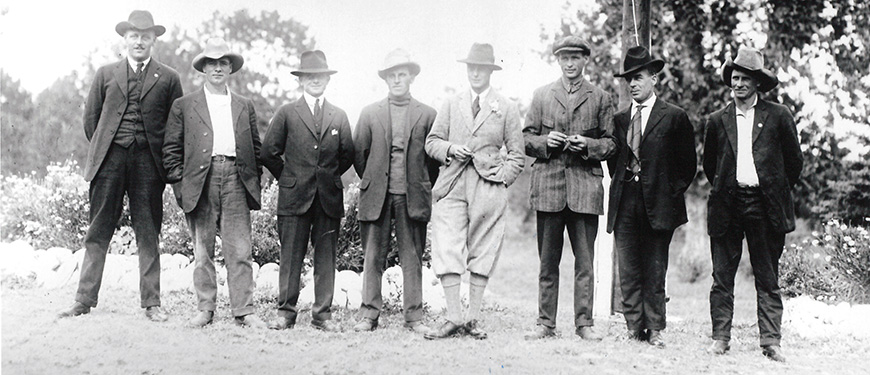
© 91.7.1.7. Florence Fleming Collection, Parks Canada
Canada's participation in the First World War shaped the country and Canadian identity. More than 600,000 Canadians served in the First World War, and more than 60,000 of them lost their lives. Parks Canada recognizes those from and associated with Bar U Ranch National Historic Site who served in the war.
When war broke out in Europe, thousands of Canadians rushed to volunteer. In the foothills where many recently arrived settlers came from the United Kingdom, support for the war effort was keen and enlistments heavy. A local paper boasted that “…we Britons here in Canada, would British honour save.”
As the war wore on recruitment became more difficult. A 1916 campaign to fill two platoons at High River saw recruitment officers travelling as far as Pekisko by car and visiting the nearby ranches, including the Bar U, on horseback. Efforts to recruit First Nations peoples also intensified with over 400 from across the prairies joining up.
The Bar U’s George Lane supported the war effort by buying large amounts of Victory Bonds and providing soldiers in nearby High River with a recreation room. Community members hosted picnics to raise funds to buy a machine gun. Wartime labour shortages sparked sharp debate in the west over the conscription of farmers’ sons. Reformers argued that the sacrifices on the battlefield should bring change at home: they succeeded in 1916 with the introduction of provincial women’s suffrage and prohibition.
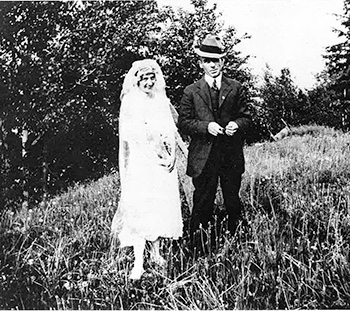
Image: Olsen family collection
Robert George “Bob” Armstrong, 1885-1968
An experienced carpenter and construction worker, Bob Armstrong was a natural fit for the Railway Construction Corps of the Canadian Expeditionary Force. The Corps built and maintained the railway lines used to transport troops and supplies to the ever shifting frontlines – all while under fire.
Armstrong arrived in France in March 1917. The Corps suffered high casualties, but Armstrong stayed out of harm’s way until after the Armistice, when his face was badly cut. Following hospitalization, he returned to Canada in May 1919.
After the war, the Bar U Ranch hired Armstrong to be its bookkeeper. Here he met and married Hazel Smith, the governess to the ranch manager’s children. They subsequently moved to Calgary where Bob continued to work for the Bar U’s owner, George Lane, at his city office.
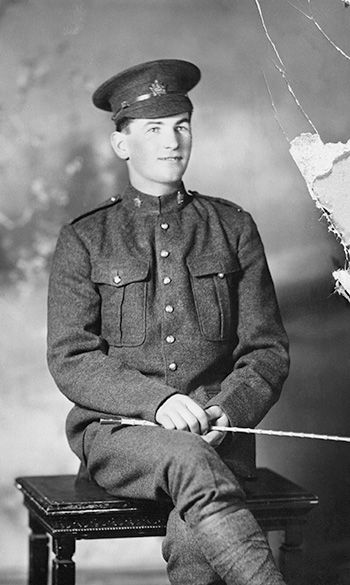
Robert Lorne “Bob” Carry, 1894-1966
Manitoba-born Bob Carry started ranching at 14. Although he was never employed at the Bar U Ranch, he did work for Pat Burns who owned the Bar U from 1927-1950.
Carry’s wartime service and resulting injury is well known in the Alberta foothills. Assigned to the 31st Battalion, Carry joined his unit in the midst of the Battle of Courcelette in 1916.
Soon afterward he was caught in an intense bombardment during which shrapnel shattered his left leg. With gangrene beginning to show, the award-winning bronco rider underwent amputation above the knee.
After nearly a year in hospital, where he was fitted with a prosthetic leg, Carry was discharged. Not one to allow injury to stand in his way, he was back in the saddle again a day after his return to Calgary.
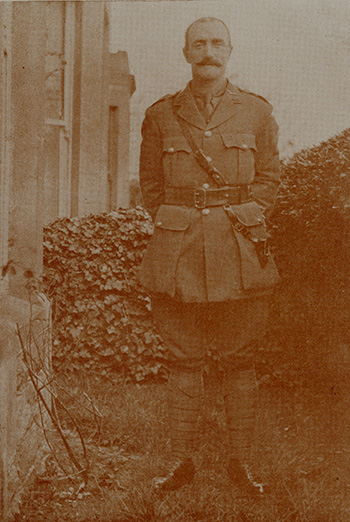
Erland Godfrey Hadow, 1875-1917, killed in action
Born into the British upper middle class, Erland Hadow immigrated to Canada in 1894. He worked on ranches in the Bar U country and participated in the newly popular sport of polo. By 1914, he was working as a land surveyor in Revelstoke. Hadow joined the Canadian Expeditionary Force in Calgary in April 1915. Once overseas, he became a Captain of the 17th West Yorkshire Regiment, British Expeditionary Force.
On the western front, Hadow put his cowboy skills to use when he lassoed German flags flying from poles planted and mined with explosives in no-man’s land. “For conspicuous gallantry on many occasions,” he was awarded the Military Cross. Erland Godfrey Hadow was killed in action in 1917. He is buried at Heudicourt cemetery in Somme, France. His wife and baby daughter later settled in Victoria.
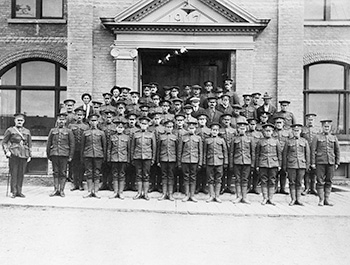
Image: Glenbow Archives
Joeseph “Joe” Johnstone, 1887-1917, killed in action
In the winter of 1916, recruiting officers for the 137th Battalion rode into the foothill ranches. Among the men they enlisted was Bar U cowboy Joseph Johnstone. Of Scottish descent, Johnstone was known as one of the most skilled horsemen in Alberta.
Johnstone embarked for France in early 1917. There he fought in the Battle of Vimy Ridge where he was wounded by a bullet above the heart. Five months later he was back in Belgium, in the waist-deep mud and shell craters of Passchendaele. Joe Johnstone was killed in action October 26, 1917.
Joe’s mother received the Memorial Cross – awarded to the mothers and widows of Canadian soldiers who died in active duty. He is buried near Ypres, Belgium, and remembered in the churchyard at Wamphray Parish Church, Scotland.

Image: Collection of the Army Museum Alberta, Julie Vincent Photography
Thomas Arthur “Art” Lowe, 1894-1976
A teamster and carpenter, Art Lowe was the son of Orrin Lowe, an employee of the Bar U Ranch and Namaka Farm. Art Lowe enlisted in June 1915 and served with Calgary’s 31st Battalion in France as a gunner. He saw action at the battles of the Somme and Vimy Ridge. For “gallantry shown in the battle of Hill 70,” at Vimy, he was awarded the Military Medal. His father received the medal at the Bar U.
A gas attack ended Lowe’s active service in March 1918. After a lengthy convalescence in England, he returned to Canada in December 1918.
The Canadian Pacific Railway’s irrigation division employed Lowe after the war at Strathmore. Art enlisted with the Royal Canadian Engineers when the Second World War began in 1939.
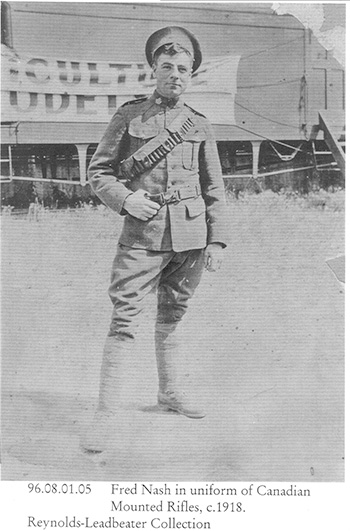
Image: Reynolds Leadbeater Collection
Fred Nash, 1891-1952
A renowned cowpuncher, Fred Nash was amongst the thousands of British-born Canadians to volunteer. With his job on the Bar U Ranch guaranteed upon his return, Fred joined the 12th Canadian Mounted Rifles, in January 1915. After months of training, he arrived in France early in 1916.
Assigned to the 8th Canadian Infantry Brigade, Nash remained on active service, right through to January 1919. He wrote home that he “had many close calls,” but was never wounded.
Nash was fortunate in other ways too. During his time in London, England, he met his future wife Florence Butterfield. They returned to the Bar U. With his ‘soldier’s preference’, Nash joined the Dominion Forest Service and acquired land north of the Bar U. Fred and Florence were well known for their hospitality, horsemanship and woodcraft skills.
"Food Will Win the War"
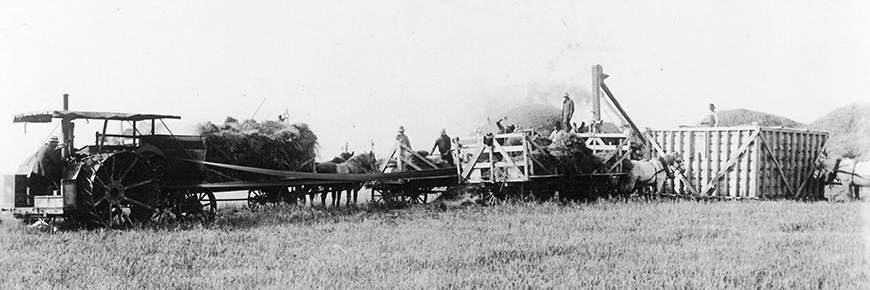
Image: Olsen Family Collection, 96.3.1.54, Parks Canada
In war, food is as crucial to victory as men and arms. At the outbreak of the First World War in 1914, agriculture was a huge part of the Canadian economy with much of her produce sold to Britain including: cheese, live cattle, pork products and wheat. With established marketing systems in place and new capacity in the recently settled west, Canada focused her wartime food policy on producing and exporting as much food as possible. By the timethe war ended the value of Canadian food exports had doubled; the Allies’ access to food supplies from overseas, including from Canada, contributed to victory in 1918.
The Bar U Ranch was part of a large southern Alberta mixed farming operation headed by George Lane. During the war, cattle ranching remained at the heart of its operations, but Lane also became one of Canada’s largest wheat producers, seeding at Bar U and his other properties. Canadian wheat helped feed the British who used it to make ‘war bread.’ Amid the war, the ranch also saw its famous Percheron herd of heavy horses reach maximum size. Percherons were used extensively for heavy hauling by the military, although none of the Bar U horses is known to have gone directly to war.
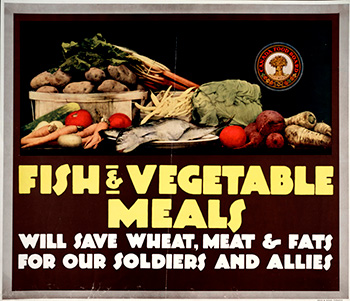
Image: Library and Archives Canada,
Do your bit - save food
During the war, Canadians at home were encouraged to do their bit by using less and not wasting or hoarding. Canadian farmers were encouraged to produce more beef and particularly more wheat but also such items as bacon and cheese. In order to supply troops with the bread, “bully” beef and beans that formed the core of their diet, those at home were encouraged to make do. Brown bread rather than white bread. Fish and vegetables rather than beef and bacon.
As the war progressed, Canadians felt the sting of rising prices and some shortages (candy and ice cream among them) but Canada’s Food Controller W.J. Hanna continued to urge a spirit of national selfdenial and co-operation in support of its troops and allies, saying “the consumption of wheat, beef and bacon in the Dominion must be reduced by at least one third to meet the needs of Allied armies and people.” A 1918 Canada Food Board poster assured Canadians that “Well Fed Soldiers Will Win the War” and featured a young soldier saying “We are saving you, YOU save FOOD.”
- Date modified :